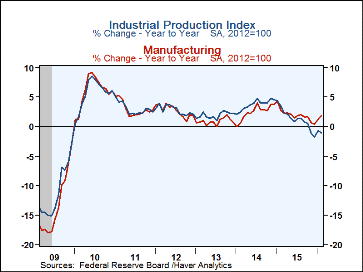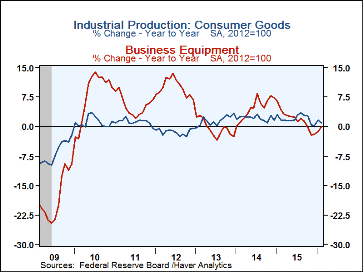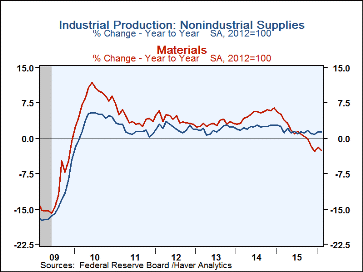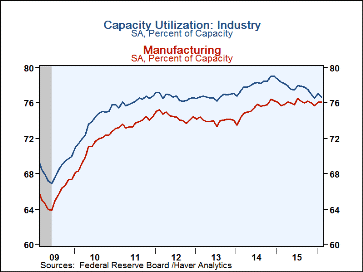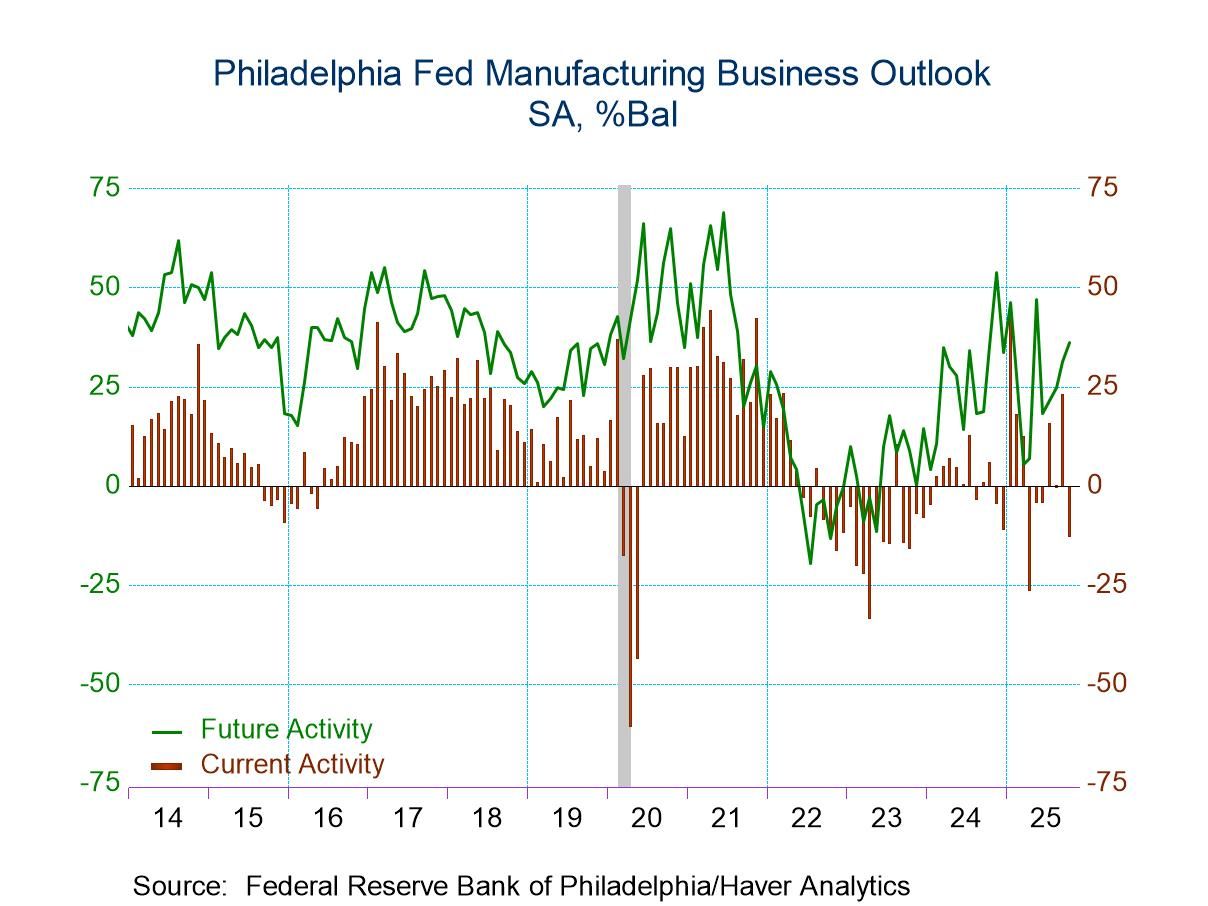 Global| Mar 16 2016
Global| Mar 16 2016U.S. Industrial Production Weakened by Lower Oil Prices and Warm Weather; Factory Output Improves Modestly
by:Tom Moeller
|in:Economy in Brief
Summary
Industrial output declined 0.5% (-1.0% y/y) last month following a 0.8% increase during January, revised from 0.9%. A 0.3% decline had been expected in the Action Economics Forecast Survey. The decline in oil prices pulled down output [...]
Industrial output declined 0.5% (-1.0% y/y) last month following a 0.8% increase during January, revised from 0.9%. A 0.3% decline had been expected in the Action Economics Forecast Survey.
The decline in oil prices pulled down output in the mining sector by 1.5% (-10.0% y/y) last month. It has fallen 12.9% since the peak in December 2014. Warm weather reduced utility output 4.0%, and it is down 9.2% from the peak in February 2015.
Factory sector production improved 0.2% (1.8% y/y) following an unrevised 0.5% rise. In the durable goods sector, production rose 0.4% (1.6% y/y) for the second straight month. Machinery production jumped 0.8% (-4.4% y/y), up for the first month in six. Primary metals output also rose 0.8% (-3.6% y/y), up for the first month in four. To the downside was motor vehicle & parts production by 0.1% (9.2% y/y), but that followed a 3.5% rise. Electrical equipment production strengthened 0.6% (7.4% y/y).
In the nondurable goods sector, industrial production eased 0.1% (+2.0% y/y) following a 0.8% rise. Textile mill output fell 1.4% (+1.8% y/y) after a 1.3% increase. Food, beverage & tobacco production fell 0.8% (+2.2% y/y) and also reversed the January gain. Offsetting these declines was a 2.9% rise (-3.8% y/y) in apparel production which mostly reversed a 3.5% January increase. Petroleum & coal production gained 2.5% (2.9% y/y) after a 0.6% rise. Chemical production was little changed (2.2% y/y).
In the subcategory groupings, high technology product production eased 0.1% (+1.4% y/y) following two firm increases. Computer & office equipment production declined 0.9% (1.8% y/y) after a 9.9% jump. Communications equipment production fell 0.4% (+3.7% y/y) following a 0.7% easing. Total factory output excluding both the auto & high technology sectors rose 0.2% (1.2% y/y) on the heels of a 0.3% rise.
Capacity utilization declined to 76.7%, down from 79.0% in December 2014. Factory sector utilization held steady m/m at 76.1%, and its been moving sideways since the end of 2014. Industry capacity rose 1.2%y/y while factory sector capacity also improved 1.2% y/y.
Industrial production and capacity data are included in Haver's USECON database, with additional detail in the IP database. The expectations figure is in the AS1REPNA database.
| Industrial Production (SA, % Change) | Feb | Jan | Dec | Feb Y/Y | 2015 | 2014 | 2013 |
|---|---|---|---|---|---|---|---|
| Total Output | -0.5 | 0.8 | -0.5 | -1.0 | 1.3 | 3.7 | 1.9 |
| Manufacturing | 0.2 | 0.5 | -0.2 | 1.8 | 2.0 | 2.5 | 0.9 |
| Consumer Goods | -0.7 | 1.8 | -0.4 | 1.0 | 2.0 | 2.2 | 1.5 |
| Business Equipment | 0.6 | 0.6 | -0.9 | -0.2 | 1.8 | 4.8 | -0.4 |
| Construction Supplies | 0.5 | -0.3 | 0.2 | 2.8 | 2.8 | 3.9 | 2.8 |
| Materials | -0.7 | 0.4 | -0.5 | -2.6 | 1.5 | 5.1 | 3.1 |
| Utilities | -4.0 | 4.2 | -1.2 | -9.2 | -0.6 | 1.0 | 2.5 |
| Mining | -1.4 | -0.7 | -1.6 | -10.0 | -1.5 | 10.8 | 6.5 |
| Capacity Utilization (%) | 76.7 | 77.1 | 76.5 | 78.4 | 77.8 | 78.1 | 76.7 |
| Manufacturing | 76.1 | 76.1 | 75.7 | 76.1 | 76.1 | 75.3 | 74.0 |
Tom Moeller
AuthorMore in Author Profile »Prior to joining Haver Analytics in 2000, Mr. Moeller worked as the Economist at Chancellor Capital Management from 1985 to 1999. There, he developed comprehensive economic forecasts and interpreted economic data for equity and fixed income portfolio managers. Also at Chancellor, Mr. Moeller worked as an equity analyst and was responsible for researching and rating companies in the economically sensitive automobile and housing industries for investment in Chancellor’s equity portfolio. Prior to joining Chancellor, Mr. Moeller was an Economist at Citibank from 1979 to 1984. He also analyzed pricing behavior in the metals industry for the Council on Wage and Price Stability in Washington, D.C. In 1999, Mr. Moeller received the award for most accurate forecast from the Forecasters' Club of New York. From 1990 to 1992 he was President of the New York Association for Business Economists. Mr. Moeller earned an M.B.A. in Finance from Fordham University, where he graduated in 1987. He holds a Bachelor of Arts in Economics from George Washington University.


